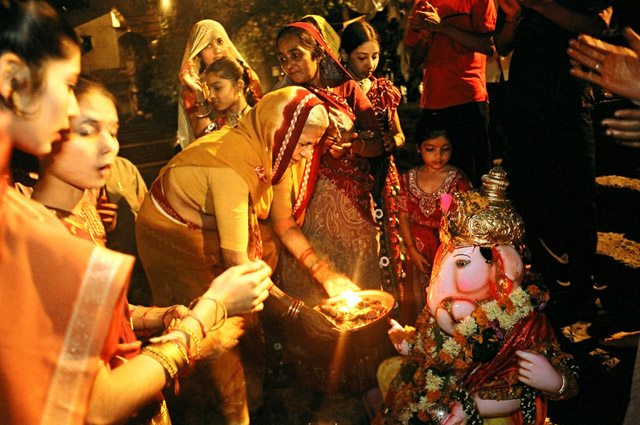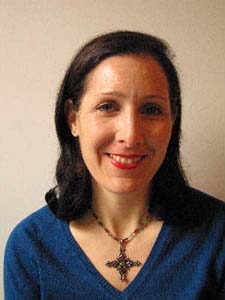
An artist searched for Ganesha and found herself…
Lord Ganesha enters people’s lives in mysterious ways – sometimes it can even be just a chance encounter on a busy New York street! When photographer Shana Dressler passed a bookstore in Manhattan, she stopped in her tracks. In the window was a photography book which had on its cover a striking 20-foot high plaster of Paris statue of the elephant-headed God in the water, being splashed by a small army of men.
Dressler knew it was Ganesha because she had taken an entry level course on Hinduism at Columbia University in 1991 when she was studying comparative religion and anthropology, and was also familiar with the image from various yoga studios where she had practiced.
But why was Ganesha partly immersed in the ocean? Intrigued, she followed up on that and finally decided to travel to India to see the Ganesha Chaturthi festival firsthand.
It was the start of an amazing journey for Dressler. “More than any particular moment, experience, monument, sacred place, what keeps bringing me back to India is the people,” she says. “I have been to 50 countries on five continents and nowhere else have I felt such a pervasive and palpable sense of spirituality that is not tied to a particular religion, person or place.”
She first went in 2003 to Mumbai where her Italian photojournalist friend Helen was living and got introduced to Sudharak Olwe, a photographer on the staff of the Times of India. Both she and her friend from New York, Diana, were there for the Ganesh Chaturthi festivities which celebrate the birth of the God of Auspicious Beginnings, and followed Olwe around since he had shot the festival for many years and knew exactly where to go.
“I began photographing the festival as an outsider observing from my American lens,” recalls Dressler. However this attitude changed as she got to know the people of Bombay, especially in the neighborhood of Wakeshwar, where she was staying. She says, “Instead of photographing Ganesha as an object, I shifted to photograph him as everyone around me saw him – as a deity. This concept was so radically different from my Judeo-Christian upbringing where paintings and sculptures are representations of God, not embodiments of God themselves.”
Indeed, it was an eye-opener for Dressler who had often photographed churches and Christian rituals but knew very little about Hinduism or the hundreds of intricate rituals which surround it. After attending several pujas she understood the powerful role faith played, and tried to photograph the festival from the perspective of a devotee as best as she could. The challenge was to capture the spirit of the rituals as an almost physical occurrence, and on a technical level this included using slower shutter speeds, film sensitive to low light, and a technique she had learned as a photography student years ago called ‘shake and bake.’
“With this technique you need to use a slow shutter speed along with a flash,” she explains. “What this creates is an image where some of your subject matter is sharp and the ambient scene around the main object creates a blur with the rest of the photograph in sharp focus. The blur for me was a way to give a sense of spirit being present as opposed to merely matter.”
Dressler had always been interested in visual arts as a means to learn about other cultures and is the founder of Swimming Elephant, a multimedia company which produces photography exhibitions, book projects and video installations to celebrate the interconnectedness of world cultures. She had earlier done a photographic project about a Pentecostal church in Harlem, tracing the role of faith in communities, and this became the impetus for her new project, Discovering Ganesha.
Back in New York, she was on a roll with Ganesha on her side: she submitted some of the images to Kodak for a film grant and won it. After her second visit to the Chaturthi celebrations in Mumbai, she approached galleries and did a slideshow at the UN. She says, “The goal of Discovering Ganesha is to educate Americans about the cultural aspects of India using Ganesha as the entry point.”
Her collaborator on the project is Sudharak Olwe, a noted photographer who in 2007 was selected as one of four international photographers in National Geographic’s prestigious All Roads Festival. Her other collaborators are Tegy Thomas who is the associate producer of Swimming Elephant and Seshu Badrinath, the photo editor of the upcoming Ganesha book, and a photo editor for ESPN.com besides being the creator of the photography blog, Tiffinbox.com.
Discovering Ganesha is very much a work in progress, and over the years Dressler and her colleagues have visited several of the Ganesha festivities in Maharashtra, Gujarat, Rajasthan, Orissa and Tamil Nadu, vidographing and shooting images for the upcoming book in which they plan to have images of Ganesha from around the world. . (www.discoveringganesh.com)
So that first encounter with Lord Ganesha has multiplied many times for Shana Dressler, and she says that having photographed the festival for four years, she has probably seen tens of thousands of images: “Each year I am so struck by the simultaneous seriousness and playfulness with which the people of Mumbai and India celebrate Ganesha. The artistic license that the artists who create the idols are given is truly inspirational and refreshing.”
Indeed, in addition to the traditional representations of Ganesha, she’s seen sculptures created out of spices, peacock feathers and even dried fruit. She’s seen Ganesha sitting on the shoulder of King Kong, sharing the stage with Harry Potter, and on a more serious note, even present at the Twin Towers on 9/11.
“What’s so moving is to see artistic representations of Ganesha that evoke a deep sense of devotion and love whether or not they instill a sense of seriousness or evoke laughter, amusement or intrigue,” she says. “In all the idols I’ve seen, never once did I feel any sense of sacrilegious intent or disrespect. What greater freedom than to see and experience God with such a great variety of creative expression?”
Dressler points out that for the world’s one billion Hindus, Ganesha is a powerful and majestic deity, said to bring good fortune when launching new endeavors. He is also considered a patron-deity of the arts and the Lord of beginnings. She adds, “The iconography and history of Ganesha go far beyond his link with good fortune. The imagery offers a spiritual map of sorts, his every feature rich with meaning, both practical and esoteric.”
In her journey of discovering Ganesha, there have been some disappointments along the way. Plans for a major exhibit at the Rubin Museum which was slated to open in 2009 fell through when the curator of the show left. There had been many small difficulties along the way such as funding the project and finding sponsors but this was the biggest blow.
Yet somehow, Ganesha’s spirit has affected Dressler, for the Remover of Obstacles seems to have interacted on her behalf in many of the hurdles she encountered. So when the museum show was canceled, she says she decided not to get upset and stay the course, flying to Mumbai to be on target with the production timeline she had put in place.
In India, even as she worked every day on the project, she had more mental space to think about the birthing pains the project was having, and whether there was some divine design behind these obstacles. “I wondered what lessons I still need to learn, what was missing in my research, what connections weren’t being made in order to have this exhibition go beyond the surface level and really move people?” she says.
“I came up with some answers, but most importantly I realized that in producing this entire project I hadn’t really been spending time looking at the sacred texts, taking the time to learn the mantras, talking to experts, pundits, and devotees to get deeper insight into what would be most meaningful to share with a Western audience.”
The cancellation of the museum show had actually given Dressler the opportunity to take the project to a much deeper level, a spiritual plane that was missing earlier. She says, “The process of putting together Discovering Ganesh really uncovered a depth of spiritual connectedness that I hadn’t experience before so viscerally. This is the first project that has really taken me through a transformation from artist to activist.”
It was now a spiritual journey where Dressler tried to understand the deeper meaning of her quest: “What does Ganesha represent for me, my journey as an artist, an individual, a non-Hindu American who grew up in another faith? Having read through his 108 names, and then another list I found of his 1000 names, what I realized is that Ganesha, as the Remover of Obstacles, inspired the deepest thought within.”
Dressler now understands that the obstacles – physical, mental, emotional, professional – were there for a reason; they were there to help her grow spiritually and take her further on the road to self discovery. Many new people came into her life and each brought new perspectives, of seeing God in every stranger, of extending a hand in help or welcome. She recalls the profound sense of hospitality and caring she encountered everywhere, be it the doctor who refused to accept any treatment fees from her because she was a guest in his neighbor’s house – or the house servant who took her home to meet her family and showered her with warm hospitality.
Then there was the journalist who took off three vacation days from his office so he could take her to an archeological site with uncovered Ganesha idols. It was a 12 hour journey and he turned right around to get back to work. Recalls Dressler with amazement, “That’s like driving from New York to Chicago for a day and then heading back!”
Perhaps this was the lesson Shana Dressler was meant to learn, this deeper aspect of seeing the Creator in all of creation. She says, “I can trace back my interest in dedicating time and money to mentoring youth, and helping those less fortunate than myself to the beginning of this project.”
She now has developed a charitable component to Discovering Ganesh. From Seshu Badrinath, the book’s photo editor, she learned about the travails of working class people who had lost their sight. Since Badrinath’s parents are physicians who run an eye hospital in Chennai, she learnt about the hardships of families where the breadwinner has lost his eyesight, and so are often pushed into poverty.
So along with raising funds for the book project, the goal is now to also raise funds for about a thousand eye operations – one for each of Ganesha’s thousand names. The eye operations cost just $ 100 each but are priceless in that they can turn a family’s fortunes around completely.
“For me, the more I free myself from my obstacles – real or imagined – I realize that what makes me the happiest is to inspire others to look within….to be less focused on myself and to really be of service to others,” says Shana Dressler. “I had to take the journey before I realized that the power to get to where I wanted to go had been with me all along, I just didn’t know it. It took the journey, the struggle, the obstacles and ultimately the help of others to figure it all out.”
© Lavina Melwani (First published in 2009 in Hinduism Today)

